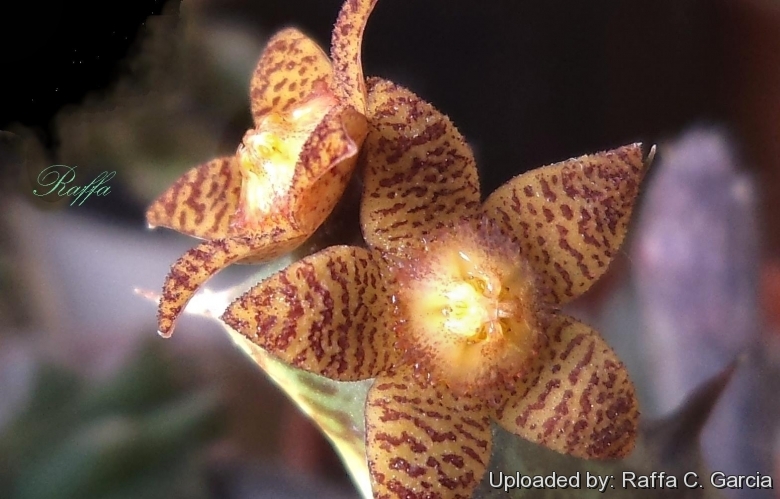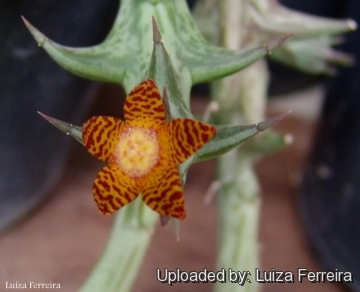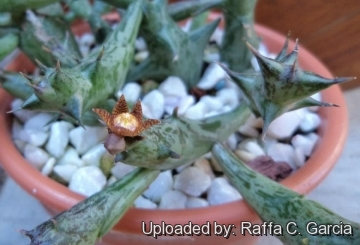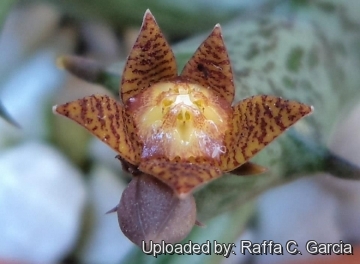
Orbea schweinfurthii Photo by: Raffa C. Garcia
Origin and Habitat: Orbea schweinfurthiiSN|30319]]SN|30319]] is native to Zaire, Tanzania, Zambia, Zimbabwe, Rwanda.
Abitat and ecology:* It grows interlocked with the stems of sparse shrubs, as usually seen with most members of the Stapelieae. In contrast to most other species of the genus Orbea, this species is not pollinated by carrion flies but by small fruit flies (Drosophila). The flower of Orbea schweinfurthiiSN|30319]]SN|30319]], smell like overripe fruits, deceiving a food source and a suitable place to lay Drosophila eggs.
Remarks: The Zimbabwean plants were known as Caralluma piaranthoidesSN|30323]]SN|30323]] (1935) until it was realised that they were identical with the more northerly C. schweinfurthii which was described in 1910.
Synonyms:
See all synonyms of Orbea schweinfurthii
back
Accepted name in llifle Database:Orbea schweinfurthii (A.Berger) BruynsAloe 37(4): 76 2000Synonymy: 5
back
Description: Orbea schweinfurthiiSN|30319]]SN|30319]] is a distinct mat-forming perennial succulent plant.
Stems: Mostly prostrate, basally slightly tapering, 8-10 cm long/high, 4- to 5-ribbed in section, strongly tuberculate. Tubercles 8-15 mm long, spreading to slightly ascending.
Leaves: Rudimentary, slightly bent upwards, with stipular rudiments.
Inflorescence: Flower stalks lateral arising at the apical part of the stems. Flowers 2-5 per head opening in quick sequence.
Flowers: Hermaphrodite, actinomorphic. Buds rounded, obtuse. Bracts, lanceolate-triangular 2.5 mm long, 1.5 mm wide, obtuse. Peduncle robust, about 3-4 mm long, 1.5 mm in diameted, pointed. Sepals 2-3 mm long, 1-1.2 mm wide. Corolla 10-15 mm in diameter, united in the central half, outside green with few red blotches, inside yellow to brown, spotted with wine-red, beige or purple. The corolla tube is very flat surrounded by a thick, fleshy annulus that embraces the corona basally. Corolla-lobes triangular-ovate, acute, 6-2 mm long, 5 10 mm wide horizontally spreading, convex inward (above), apically somewhat arched outwards, inside the surface is more or less densely tuberculate-papillose, mostly yellow to brown with transverse, irregular, burgundy, beige and purple stripes or spots. Outside green with some red spots. Inner corona-lobes cream-coloured 4-5.5 mm in diameter surrounded by the outer-corona lobes. Pollinia D-shaped very small ( 0.3 × 0.3 mm) transported by small Drosophila flies. The flowers give off a sickly-sweet scent that smells like an overripe orange or pineapple.
Blooming season: Summer-autumn.
Fruits: A pair of follicles.
Bibliography: Major references and further lectures
1) Doreen Court “Succulent Flora of Southern Africa” CRC Press, 01 June 2000
2) Focke Albers, Ulrich Meve “Illustrated Handbook of Succulent Plants: Asclepiadaceae: Asclepiadaceae” Volume 4 Springer Science & Business Media, 2002
3) A. K. Shukla, M. R. Vijayaraghavan und B. Chaudhry “Biology of pollen” New Delhi, S.B. Nangia for APH Pub., 1998
4) Peter Vincent Bruyns: “New combinations in the genus Orbea.” In: Aloe, 37 (4): 72-76. 2001.
5) Peter V. Bruyns “Monograph of Orbea and Ballyanthus (Apocynaceae – Asclepiadoideae – Ceropegieae).” In: Systematic Botany Monographs, 63, 2002, American Society of Plant Taxonomists, Ann Arbor.
6) Alwin Berger “Stapelieen und Kleinien einschliesslich einiger anderer verwandter Sukkulenten Beschreibung und Anleitung zum Bestimmen der wichtigen Arten mit kurzer Angabe über die Kultur” Stuttgart, Ulmer, 1910
7) Michael George Gilbert: “A review of Caralluma R. Br. and its segregates”. In: Bradleya, 8: 1-32. 1990.
8) Darrel C. H. Plowes: “The taxonomy of the genera Pachycymbium Leach und Angolluma Munster (Stapelieae: Asclepiadaceae).” In: Excelsa, 16: 103-123.1994
9) Orbea schweinfurthii in: List South. African Succ. Pl.: 28, 1997
10) Orbea schweinfurthii in: Syst. Bot. Monogr. 63: 33-36, 2002
 Orbea schweinfurthii Photo by: Luiza Ferreira
Orbea schweinfurthii Photo by: Luiza Ferreira Orbea schweinfurthii Photo by: Raffa C. Garcia
Orbea schweinfurthii Photo by: Raffa C. Garcia Orbea schweinfurthii Photo by: Raffa C. Garcia
Orbea schweinfurthii Photo by: Raffa C. GarciaSend a photo of this plant.The gallery now contains thousands of pictures, however it is possible to do even more. We are, of course, seeking photos of species not yet shown in the gallery but not only that, we are also looking for better pictures than those already present.
Read More... Cultivation and Propagation: Orbea schweinfurthiiSN|30319]]SN|30319]] grow well in light gritty soil with a very liberal drainage. They should at all times sparingly watered (best rain water with some occasional fertiliser), and in winter time they hardly require any. They require outdoor culture, or a warm close greenhouse, while growing in the early part of summer, and afterwards may be ripened and kept in a greenhouse; but as they bloom chiefly in autumn, warmth is desirable to enable them to expand their flowers.
A minimum winter temperature of 5-10°C is acceptable, providing that plants are kept absolutely dry. They prefer light shade rather than full sun, although stems may not colour up under shady conditions.
Propagation: Plants are usually increased by cuttings, which, as they are very succulent, should be allowed to dry a week after they are taken off, when they may at once be put singly into pots.
Pest & diseases: Keep their roots free of mealy bugs, as fungal attack often occurs as a result of damage to stems by insects. A layer of grit on the surface of the compost prevents moisture from accumulating around the base of the stems and minimise the chance of fungal attack on the roots.
Traditional uses: This species is sporadically collected for food by local people.













